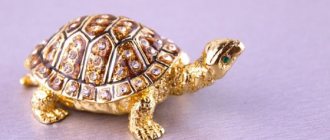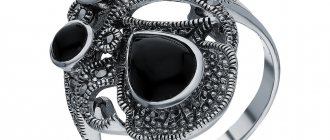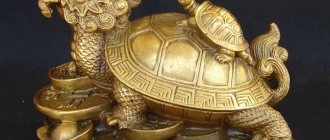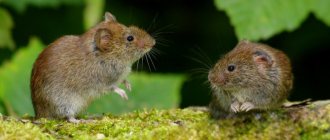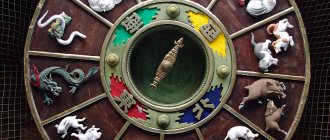One of the symbols of the harmony of the universe, which is professed by the teachings of Feng Shui, is the Dragon Turtle talisman. It is an extraordinary mystical animal with the head of a dragon and the body of a turtle. The main tasks that the talisman performs are to protect the home from any negative energy, from everything bad and unclean that can penetrate it. The dragon turtle talisman is a special item that has magical powers, capable of protecting a person from troubles and misfortunes and giving him strength and power. Feng Shui masters say that with the help of a talisman you can attract good energy that will help improve your life.
After all, our home is our fortress, so the energy in it should be clean and good. The dragon turtle has another very important and unique property. Let's start with the fact that the planet Jupiter occupies a special place in the life of great China, and the Chinese people treat this planet with boundless respect. Jupiter revolves around the Sun every 12 years, passing through one zodiac sign every year. For this, the planet Jupiter is respectfully called the Prince of the Year. The well-known eastern calendar is compiled precisely according to the location of Jupiter relative to the constellations. When a planet passes, for example, through the constellation Draco or Rat, according to the Chinese calendar, a year with the same name is celebrated on earth. It is believed that under no circumstances should the location of the Prince of the Year be disturbed in the house; peace and tranquility should always reign there. It is believed that construction and repair work should not be carried out in the Tai Sui or Jupiter zone, as this may cause indignation and anger of the Grand Duke. It is necessary to plan your home so that there are no high-activity rooms in the direction of the Prince of the Year: living room, kitchen, hallway, because this can cause various unpleasant events to happen to household members, and problems will arise on their own. You also cannot sit opposite Tai Sui; it is better if he is behind you. Otherwise you will be haunted by failure. But the Dragon Turtle talisman will pacify the anger of the Grand Duke, protect you and ward off trouble. After all, when the Dragon Turtle looks at him, the Prince of the Year calms down, and his anger towards people subsides. Therefore, the talisman should always be in the house, you just need to rearrange it depending on which constellation Jupiter is in.
Origin of the dragon turtle
How did the Dragon Turtle appear in the first place? According to the ancient legend, when the time came for the last dragon, the brother of the Chinese emperor, to die, he was very sad. After all, he had no one to leave the Celestial Empire to, no one to transfer his power to, he had no heirs. And then the turtle, the keeper of wisdom, gave her body to the dragon to ward off trouble from the Chinese people. From this union came the Dragon Turtle, who combined the strength and wisdom of the two great patrons of China.
Dragon Turtle
The purpose of the talisman
The Dragon Turtle is a magical animal with the head of a dragon and the body of a turtle, a symbol of the harmony of the universe, which is one of the standards expressing the philosophy of Feng Shui.
The functions of the talisman are to protect the house from everything bad that can penetrate or accumulate in it. In addition, the Dragon Turtle has specific abilities inherent in few Feng Shui talismans. The fact is that in China the Jupiter beam is highly respected; the Chinese even name the year in accordance with the position of Jupiter. For example, Goat and Monkey correspond to the southwest direction, Rooster to the west, etc. Therefore, when Jupiter passes through these constellations and directions, we have the year of the Goat, Monkey or Rooster. Jupiter, Tai Sui, is respectfully called the Grand Duke of the Year. It is believed that it is impermissible to disturb its location; there should be peace there. Therefore, it is very unfavorable to carry out any work (repairs, construction) in the zone of the Prince of the Year, since any activity in the corresponding direction causes the indignation of the Grand Duke of the Year. If your front door, kitchen, living room, office or any other room of increased activity is in the direction of the Prince of the Year, then problems are possible in any aspect of human life. It is also unfavorable to sit opposite the Grand Duke of the Year, it brings bad luck. It's good to have the Prince of the Year at your back. A turtle with a dragon's head can calm him down. It is believed that the Grand Duke of the Year of Tai Sui likes to have the Dragon Turtle look at him, and the prince does not take out his anger on people. So this talisman is a unique protector; you just need to change its habitat depending on the prevailing direction of the year. Activation of the talisman
The power of the talisman is increased by everything that symbolizes wisdom: books, manuscripts, office equipment (computers, typewriters, fountain pens, pencils, etc.).
You should definitely put one of these objects next to the Dragon Turtle, but in no case should you keep broken pencils or blank paper next to the talisman - the Dragon Turtle will try his best to do everything so that notes appear on the sheets of paper and the pencils take on a working appearance, and will cease to “protect” the owner’s home. Legend says
According to ancient Chinese legend, this mythical creature appeared from the union of a dragon (the elder brother of the Chinese emperors) and a turtle, the guardian of truth and wisdom. When the last dragon was about to die, he was very worried that he would leave the Celestial Empire without his wise leadership and protection. The turtle, realizing that with the death of the dragon, great trouble could come to the country, gave his body to the spirit of the dragon. Thus, the two strongest patrons of China united. ]
Great talismans of feng shui Lenizdat, “Leningrad”, 2006
text Elena Shishkina, Eduard Dominov
Medium sized turtle. The length of the shell is from 18 to 30 cm, depending on the sex of the turtle and the subspecies. Males are noticeably smaller than females. In young animals the carapace is bright green; with age it becomes olive or yellow-brown, decorated with patterns of yellow stripes. On the head, neck and limbs the turtle is decorated with a pattern of white and green wavy stripes and spots. The turtle got its name because of two elongated bright red spots next to its eyes. This spot can be orange, bright yellow in the subspecies of the Cumberland turtle, or Troost's turtle, or yellow in the subspecies of the yellow-bellied turtle. The bottom of the shell is oval, usually dark in color with yellow lines and a yellow edging along the edge.
Pond slider
can be considered a long-liver. Under favorable conditions, it may well live 30 - 40 years. At the same time, the turtle has a fairly high level of intelligence, which is several times greater than the intelligence of many reptiles. It is able to perceive sounds at very low frequencies. For example, the red-eared turtle senses soil vibrations and the approach of a person or animal at a level of 1000-3000 hertz. At the same time, representatives of this species are endowed with very acute vision. So, when looking for food, they first pay attention to the color of the object, and only then to the smell and taste. In addition, the females are very fertile, and the small turtles that are born are very hardy and grow quickly. The size of a newborn baby is about 3 cm; in adults it is 10 times larger. Moreover, females are much larger than males. Over the course of a year, the shell grows by 1 cm; this rapid process is facilitated by food high in protein. But turtles kept at home are 15-20 cm smaller than their free-living relatives and do not experience discomfort due to cramped housing.
The red-eared turtle is widespread in nature. Its range covers the United States from southern Virginia to northern Florida and Kansas, Oklahoma and New Mexico in the west, Mexico, all of Central America, northwestern South America (northern Colombia and Venezuela). The species was introduced to the south of Florida, Arizona, Guadeloupe, Israel, South Africa and some European countries. In particular, to Spain and Great Britain. The red-eared slider has entered Australia, where it is officially recognized as a pest, displacing local endemic fauna.
In nature, it lives in small lakes, ponds and other bodies of water with low, swampy shores. Leads a relatively sedentary lifestyle. Extremely curious. If the turtle is full, it crawls ashore and basks in the sun. If hungry, it swims slowly in search of food. When the water temperature is below +18 °C, the turtle becomes lethargic and loses its appetite. The turtle is able to notice danger at a distance of 30-40 m, after which it slides into the water with lightning speed, which is why it received the name “Slider”.
The turtle's vocal cords are not developed. All he can do is hiss and snort with excitement. The red-eared slider has well-developed vision and sense of smell. In contrast to vision, hearing is poorly developed. However, red-eared turtles are very good at navigating by hearing and hide in the water at any rustle. It not only hisses, but also makes a sound similar to a short squeak.
The red-eared turtle, contrary to popular belief among ordinary people, is very agile and fast. With these qualities, she could well compete with some types of fish, and it is not a fact that she would come to the finish line second. This representative does not lose its agility even on land. Here, as quickly as in water, she is able to avoid obstacles in her path and hide from her pursuers.
The red-eared turtle has no teeth, but thanks to the remarkable strength of its jaw muscles, it can crush a fairly strong object. When threatened by other inhabitants of flora and fauna, the individual throws its head forward with lightning speed and bites its offender. Adults of this species can inflict serious wounds while defending their lives. At the same time, the red-eared beauty can scratch, her nails are strong and very sharp, which she also often uses for self-defense. People should beware of the hind legs of this creature, because the turtle will try to push off their hands with them. Therefore, experts do not recommend pulling the red-eared turtle out of the water for children. This should be done by adults: very carefully and without squeezing the shell, while keeping it at a decent distance from the face and areas with open skin.
An adult turtle needs an aquaterrarium with a volume of 100-150 liters, preferably that land occupies about 25% of its area. If possible, soil or crushed stone is poured on the shore. A gentle ascent with a rough but non-scratching surface is arranged to land. The water level must be greater than the width of the shell, so that if the turtle finds itself on its back, for any reason, it can turn over and not drown.
The water temperature in the aquarium should not be lowered below 20°C, the normal temperature is 24-30°C (it is advisable to install a heater to maintain the temperature). The water in the aquarium is replaced as needed, 1 - 2 times a week. A water filter allows you to do this much less often. However, a complete water change should be done at least once a month. It is advisable to install an incandescent lamp above the island in the aquarium. Turtles love to bask on dry land. Also, for the normal maintenance of a red-eared turtle, a source of dosed ultraviolet radiation is necessary.
In captivity, the diet of red-eared turtles includes small crustaceans such as gammarus or shrimp. Small aquarium or river snails, small or cut into pieces fish, meat cut into small strips, liver, small frogs, tadpoles, various insects and their larvae, earthworms, bloodworms, and tubifex are also suitable.
Do not forget that the diet of red-eared turtles should include foods rich in calcium: fish heads, bone meal, chalk, eggshells, etc. The diet of adult turtles also includes plant foods. Pets eat well dandelion leaves, cabbage, lettuce, spinach, and plantain. Among algae, duckweed, elodea, spirogyra, seaweed, anacharis, water beetle, edogonium, etc. are well eaten. Young red-eared turtles are fed 2 times a day. Later they are transferred to single meals. Turtles over 2 years old should be fed no more than 2-3 times a week.
You should not feed your turtle the same thing; the diet should be varied. The amount of food is selected so that the turtles eat everything without leaving anything in the water. Turtles should be fed at the same time every day. It’s good if the turtle has warmed up well before this. At a temperature of 28-30°, turtle digestion is much more intense. You can also feed turtles outside the aquarium, for example in a basin with water. This will help keep the aquarium clean. If the turtle's food is not particularly varied, it should be given vitamins or vitamin complexes. You can find them in pet stores; choose ones marked “for reptiles.” Vitamins are fed to hungry turtles in their food. The dosage must be looked at in the instructions for the drug.
Reproduction of red-eared turtles
Juvenile red-eared sliders are essentially the same regardless of gender. Determining the sex of animals becomes possible when they become adults. Already at the age of more than one year, sex differences begin to be observed in turtles. The sex of the red-eared slider is easier to determine in comparison with other individuals. Females, as a rule, grow much larger than males. Although, given the age difference between animals, this sign cannot be used. Males have longer claws on their front paws than females. They serve for the courtship dance and help to stay on the female during mating. The male's tail is thicker and longer than that of the female. The lower part of the body in females is flat, while in males it is concave. The spots on the turtle's head are larger and brighter in color in males. In nature, turtles reach sexual maturity at 5-6 years; in captivity, this occurs somewhat earlier.
The courtship period for red-eared turtles occurs between March and July, and in captivity it can occur at any time of the year. The male swims in front of the female, tail first, and gently touches her muzzle with his claws, as if trying to stroke her. If the female is ready to reproduce, then she accepts courtship, otherwise the female drives the male away. In some cases it comes to a brawl. Young turtles can also perform a mating dance, but before they reach reproductive age they are unable to reproduce.
After successful mating, the female spends more time in the sun. Her eating habits may change, the amount of food she eats will change, and she may refuse some types of usual food. This is a normal reaction, you should try feeding her other foods and adjusting the amount of food.
Pregnancy lasts on average about two months; if the female cannot find a suitable place for laying, this period can be extended. During the last two weeks, the female spends a lot of time on land, sniffing and digging. Having chosen a place, the turtle generously moistens the soil from the anal bladders and digs a nest with its hind legs. A female red-eared turtle can lay from 1 to 22 eggs, with an average of 5-10. She has no instinct to care for her offspring. Having laid eggs, the female leaves the nest.
The incubation period lasts 100-150 days. Incubation time and sex of young turtles depend on the temperature at which the eggs are incubated. At temperatures above 29°C, females are born; below 27°C, only males are born. To pierce the egg shell, turtles use an egg tooth, which falls off an hour after birth. After the egg hatches, a small pouch is present on the newborn’s stomach; it contains the remains of food from the incubation period. Soon it will disappear, and the small wound remaining in its place will heal happily.
Diseases and treatment of red-eared turtles
The most common disease in red-eared turtles is pneumonia. Experts do not recommend keeping these exotic pets outside of an aquarium. The owners of a turtle sometimes let it walk around the apartment, thinking that it will be useful for their pet. In fact, this can be very dangerous, because the reptile can get caught in a draft and catch a cold. This also applies to the location of the terrarium; try to place it only in a place protected from wind and drafts.
If you notice that your animal is lethargic, is not eating well, or has refused to eat at all, it is most likely suffering from pneumonia. In an aquarium, the reptile swims only on the surface; it simply cannot dive. Your pet is probably hypothermic. It can be treated in two ways.
The traditional medicinal method involves a course of intramuscular injections. Keep in mind that red-eared turtles should only be treated under the supervision of a veterinarian. Self-medication can cost your pet's life. And don’t forget about an important point: when you calculate the amount of medicine by the weight of the turtle, you need to subtract the weight of the shell. To do this, just divide the total weight in half.
Some turtle owners are afraid to use medications and resort to traditional medicine. One of the methods is based on steam baths. You need to prepare a chamomile decoction. Next, you should slightly heat the broth and hold the turtle over the steam for a while. Monitor the steam temperature. it shouldn't burn your hand. Now we are preparing a warm bath. In a ratio of 1:3, dilute chamomile decoction in water, the temperature should be about 30°C. A turtle should take medicinal baths for about an hour.
Eye diseases of red-eared turtles
. Monitor the animal constantly. Examine your eyes. If you notice swelling of the eyelids, excessive discharge from the eyes, or a purple color of the mucous membranes, be sure to go to a specialist. To treat eye diseases in red-eared turtles, they must be kept on land. It is necessary to treat the affected mucous membrane with a veterinary agent. These may be antibiotics or sulfonamides. You should take a clean bath at a temperature of 28°C once a day for several hours. The water must be absolutely clean. Treatment is carried out until the veterinarian confirms recovery.
Shell diseases of red-eared turtles
. Symptoms of pet turtle disease include soft-touch shells, lethargic behavior, and poor appetite. Most often, symptoms appear from a lack of ultraviolet radiation, poor absorption of calcium and vitamin D3. To eliminate such problems, expose your pets to a UV lamp every day. This lamp can be purchased at a pet store.
To treat this disease, red-eared turtles should have raw fish in their diet daily, preferably with small bones. Include calcium and vitamin supplements in your diet. Turtle shell diseases are dangerous and their treatment should be carried out under the supervision of a specialist. You should react especially quickly if the animal experiences detachment of the horny plates from the shell. With active growth, this phenomenon is acceptable, but with age it can only occur if the reptile is not kept properly. Preventing and treating disease for red-eared sliders means careful care. This also applies to diet. Perhaps this violation is a consequence of drying out. Detachment can be caused by fungus or blue-green algae.
And in the end, in a concise form, we will present all the rules that must be followed when keeping red-eared turtles.
When keeping red-eared turtles, you must not:
keep in close quarters; keep the turtle in an aquarium without land; a turtle is capable of drowning, despite the fact that it is aquatic; keep the turtle without heating; feed turtles only raw meat; feed turtles only plant food; if the turtle does not receive food rich in calcium, it is necessary to give mineral supplements; add oil vitamins to the food “by eye”; keep turtles in dirty water, especially if a film forms on the surface; clean the turtle with rough brushes and even more so remove the horny scutes if it is overgrown with algae; keep several males in one aquarium and introduce new animals without prior quarantine; use only smooth materials (glass, plastic) for the construction of the ladder and island; wash the aquarium in the kitchen and use dishes for turtles in which food for humans is prepared. Clean the aquaterrarium irregularly; hibernation is not necessary for turtles;
Turtle figurine – looks like a turtle made of ceramic or metal, can be gilded or silver plated, or have a different appearance. Most often, turtles are found on a pile of coins, sometimes on another surface or without it.
The turtle is an ancient and very powerful talisman; it is a symbol of wisdom, longevity and health. The turtle is the guardian of the house, so it should be present in any home.
The turtle symbolizes movement forward. A figurine of such an animal helps to attract good luck to your home and achieve your goals.
Meanings and properties of the talisman
According to Feng Shui, the turtle represents a long happy life, health, wisdom, patience, endurance and the ability to see opportunities where others do not notice them. The animal helps hardworking and persistent people to slowly but surely and systematically advance in their careers. But the turtle will not help the lazy and weak-willed.
In addition to helping in business, the symbol also:
- Attracts good luck to the house.
- Prevents any kind of conflicts.
- Strengthens relationships between spouses, relatives, friends and colleagues.
- Promotes gradual and stable growth of well-being.
The image of an animal is of particular benefit to the head of the family. A home amulet attracts monetary luck to him and provides support in all endeavors.
Where to place a feng shui turtle
It is better to place the turtle in the northern part of the home
, or even better, put it on a shelf behind your back.
If you place the figurine in the workplace
, it will promote advancement at work, and a durable shell will protect you from competitors and a picky boss.
But again, the turtle needs to be placed on the north side of the office, and preferably behind one’s back
.
Do not forget that the turtle loves water and vegetation - therefore, the best effect can be achieved if you place it next to a living plant or water
(for example, a fountain, an aquarium). Figurines depicting a family of turtles can be placed anywhere, but not in the bedroom.
A living turtle will also be an excellent talisman - if you take good care of it, the family will have good health, happiness and financial well-being.
Alexander, November 8, 2014. Sunday
Water Ox Day
Day indicator: 11, “opening”
Constellation of the day: 4, "House"
Storage star
Lunar day 11/12, 14.09
Moon in Cancer/Leo, 03.55
Turtle symbolism
As already mentioned, turtles occupied an important place in the beliefs of various peoples. The Chinese considered turtles to be animals with strong magical energy. In this country, people have been telling fortunes on turtle shells for a long time and preparing medicinal tinctures. And today in China the turtle is considered a symbol of the Universe. According to legend, the shell of a turtle is the sky, and the belly is the earth.
The turtle is an ancient and highly respected symbol.
In Taoism, this animal is a symbol of the Great Triad; it symbolizes simultaneously water, sky and earth.
The turtle is often called the Black Warrior. This nickname appeared due to the fact that the turtle represents all life on this earth. This animal is leisurely, but very consistent. The turtle moves slowly, but does not deviate from its chosen path in life and always reaches its destination. It is these properties that can appear in a person if he uses a talisman in the form of a turtle.
